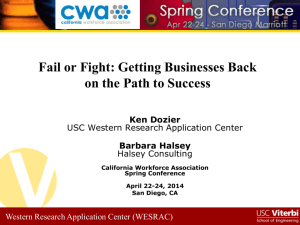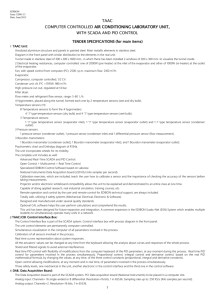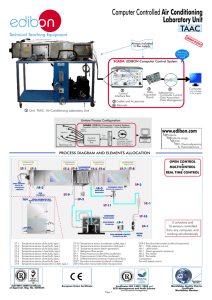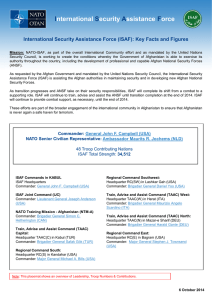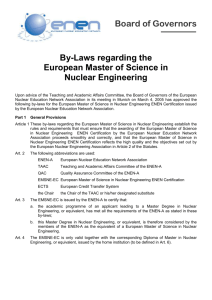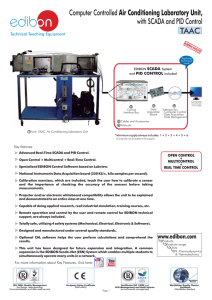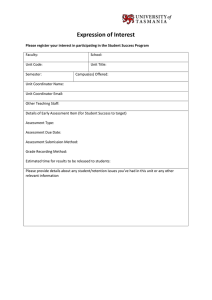University of California, Riverside Teaching Assistant Allocation Committee (TAAC)
advertisement
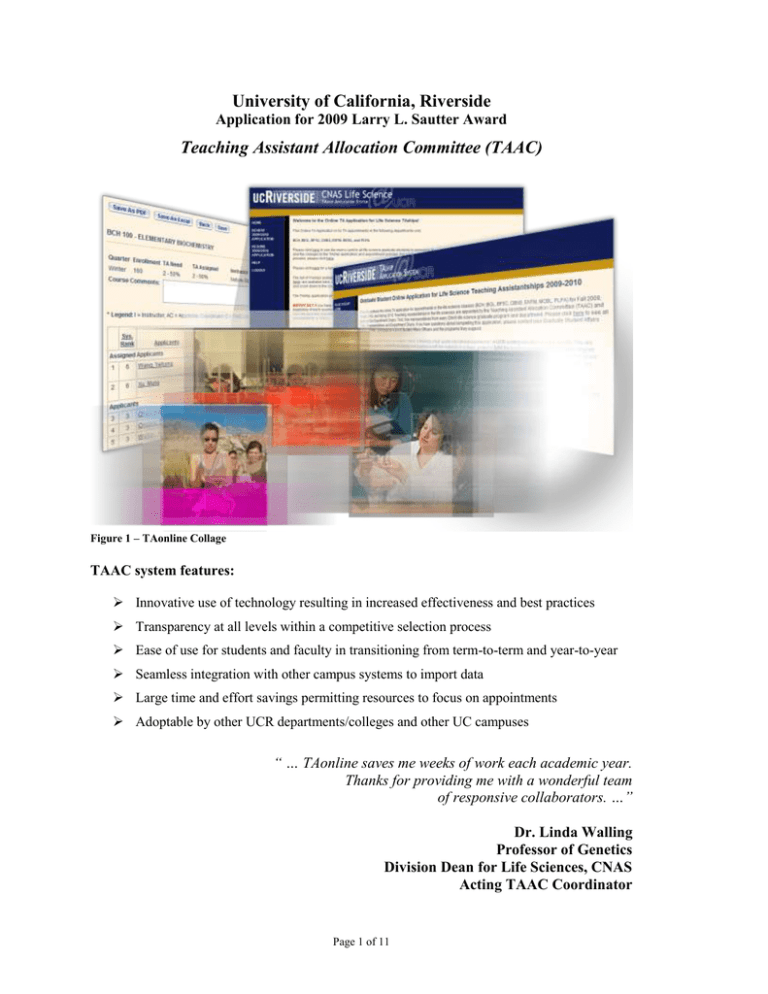
University of California, Riverside Application for 2009 Larry L. Sautter Award Teaching Assistant Allocation Committee (TAAC) Figure 1 – TAonline Collage TAAC system features: Innovative use of technology resulting in increased effectiveness and best practices Transparency at all levels within a competitive selection process Ease of use for students and faculty in transitioning from term-to-term and year-to-year Seamless integration with other campus systems to import data Large time and effort savings permitting resources to focus on appointments Adoptable by other UCR departments/colleges and other UC campuses “ … TAonline saves me weeks of work each academic year. Thanks for providing me with a wonderful team of responsive collaborators. …” Dr. Linda Walling Professor of Genetics Division Dean for Life Sciences, CNAS Acting TAAC Coordinator Page 1 of 11 Overview: TAships are awarded based on multiple criteria, including a student's knowledge and experience with the materials in a class, a need to fulfill the teaching requirements for their degree program, financial need, instructor request for a specific student to be a TA, and a desire to attain teaching experience to achieve future career goals. The Teaching Assistant Allocation Committee (TAAC) is a body of faculty members who are tasked with the selection of the most qualified graduate students who have applied to TA courses and who meet the criteria set forth within College of Natural and Agricultural Sciences (CNAS) TA Policies. Prior to the TA online system, the TAAC Coordinator would begin working on the upcoming term’s TA manual allocation system several weeks before making a call for student applications. The TAAC Coordinator utilized voluminous Excel worksheets to document a myriad of requirements. After receipt of the student applications, the TAAC Coordinator would input massive amounts of student data into the worksheets. Working with the volume of data required rigid version control to maintain the integrity of the worksheets. The significant amount of time and effort by the TAAC Coordinator to gather and consolidate the necessary data for review by the TAAC committee was immediately followed by three to four TAAC meetings which typically would take 2 hours to consult and make collective decisions on the TA allocations. After the decisions were made by the Committee, the administrative staff would then proceed with a rather prolonged manual process of notifying students, major professors, program advisors, department chairs, program chairs, etc. of the TAAC decisions. The former method of the TA allocation process represented an arduous and timeconsuming process which consumed untold hours and which needed to be performed three times within each academic year. Project Summary: The Teaching Assistant Allocation Committee (TAAC) needed a web-based teaching assistant allocation system that would allow graduate students to electronically submit T.A. applications for the TAships they require. In parallel with the submittal of students’ T.A. applications, the system allows instructors, academic coordinators, program advisors, major professors, and other faculty mentors to electronically nominate those graduate students to whom they would like to award the TAships. The broad solution is comprised of two major processes: (1) the electronic submittal of student TA applications, and (2) the faculty and TAAC review, evaluation, and final Page 2 of 11 decisions of the TA submittals. For a graphic illustration of these processes, please see Figure 2- Student Flow Process and Figure 3-Faculty Process Flow on the following pages. Student Process TA Online Student Application Flow This diagram represents the student Student Completes Application side of the Teaching Assistant Application process. As noted in the Email notice to Student illustration, the process starting from Application RETURNED Major Professor/ Faculty Mentor reviews application: Approves, Not Approves, or Returns to Applicant top down begins with the student’s completion of an online TA application. The process proceeds in Application APPROVED Application RETURNED prescribed manner through all necessary approvals. At each stage of Program Advisor reviews application: Approves, Not Approves, or Returns to Applicant the student approval/non-approval process, emails are automatically generated. Application APPROVED Teaching Assistant Allocation Committee Selects TA Candidates Figure 2 - Student Flow Process Page 3 of 11 Faculty Process The processes illustrated in the flow chart at left occur in parallel to the student application submission and approval process. The Instructors, Academic Coordinators, Department TAAC Reps, and Program TAAC reps may request and/or exclude students based upon pre-defined policies. Again, this process is all email enabled. Figure 3 - Faculty and TAAC Process Project Team Members: Jack Cui Toni Henderson Mary Livaudais Eric Martin Joanna Nguyen Page 4 of 11 TAAC Project Highlights: Redeployment ability While TAonline was created for CNAS, it was designed to accommodate any entity and/or department. Presently, other departments within in the college are collaborating with C&C on the usage of TAonline for their TAship programs. Code Share It is noted that while all the UC’s offer TAship information on their websites, only a handful offer an online program. UCR’s TAAC is an ambitious and robust on-line system that fully accommodates both student and faculty TAship needs. In this time of economic setbacks, this program could offer real and substantial value to other UC’s in terms of financial savings and resource leveraging in the management of their TAships. UCR is prepared to collaborate with other UCs towards this end. Transparency Because the program is thoroughly transparent and records can be archived for years, data is easily retrievable for audit purposes. The processes are easily tracked from the initial student application submittal through the faculty and TAAC decision-making. Self-Sustaining from Academic Year and Term-to-Term Self-sustainability is one of the major project highlights of TAAC. The Staff Administrator controls the events that occur within the TAAC system by performing tasks within the set-up page for the academic year and the Maintain Processes set up for each term within the academic year. See Figure 4-Academic Year Setup on the following page. Page 5 of 11 Set-up Processes Figure 4 – Academic Year Set-up Within the Academic Year Setup page, a menu appears that lists all the steps that need to be completed for the TA process for the new year. When each of the steps is completed, a checkmark appears. Within the Maintain Processes page, Figure 5, a process is opened by selecting the start and end dates. When a process opens, emails are automatically generated to the each role affected, i.e., Instructor, Academic Coordinator, etc., notifying them that they must go to their respective website pages and review and/or perform their assigned tasks, i.e., make Requests for Inclusion/Exclusion of students for TAship. Page 6 of 11 Figure 5 - Maintain Processes Other highlights include the following: Validation through Central Accounting System (CAS) using NetID authentication Transparency at all levels Robust reporting mechanism Automated email generation Ad hoc email capability for non-standard email functionality Incorporation of business rules and policies Integration with other campus systems to import data Archive capabilities Paperless “green” process contributes to a healthy environment Requires near-zero human intervention Easy set up processes / maintenance Page 7 of 11 High client satisfaction Reduced TAAC process time allows focus on the core selection process Roles: The TAonline system has several roles: Student Students can sign on to taonline.ucr.edu after receiving an email notification that the process has been opened to submit TA applications. Students have the capability to complete the application sections in whatever order they desire. A menu of sections is always available to the student reminding them of sections completed and those not completed. Students can review/edit their applications at any time during the open student submittal process. After application submittal, students receive notification of their approval or non-approval, or a request to modify and resubmit their applications. Major Professor, Instructor, Academic Coordinator, TAAC Program Representative, TAAC Department Representative These roles sign-in to their pages after receiving email notification that the process has been opened to submit their Requests for Inclusion/Exclusion. A link is contained within the email notification that will take them to the signin page. TAAC Coordinator This role represents the head of the TAAC Committee and has full access and rights within the TA online system. The TAAC Coordinator determines the calendar year events for TAAC, prepares for and leads the TAAC meetings, and works closely with the Staff Administrator. Staff Administrator The Staff Administrator is responsible for setting up the Academic Year processes, and Maintains the Processes for the terms within the year. This person is also responsible for sending various emails through the Ad Hoc email functionality. Financial Analysts and Students Affairs Officers These roles have access to the TAAC online system for the purpose of making queries, creating and printing reports, and performing trend analyses. Page 8 of 11 Technical and System Overview: The system is built on an Oracle database with Oracle’s procedural language, PL/SQL. Timeframe of Implementation: Concept and design commenced in January 2007. The software was deployed to students, designated faculty, and TAAC in April of 2007. While initial deployment was most successful and well received, the system was further enhanced in Spring 2008 to include a term-to-term foundation rather than an academic year base. This enhancement made the system even more flexible and easy to use for all concerned. This enhancement was deployed in Fall 2008. The system is now entering its 3rd academic year and continues to impress and delight those who use it. Objective Customer Satisfaction Because student and course information is consolidated, summarized, and hyperlinked within the Teaching Assistant Assignment Grid, Figure 6, the actual TAAC selection process is streamlined and efficient. (Student names are intentionally blurred.) Figure 6 – Teaching Assistant Assignment Grid “…marvel at the rapidity that the TAAC representatives could make informed decisions. Our ability to access student applications to determine graduate student preparedness … has truly enabled our meetings.” Page 9 of 11 “…It only took two hours to make the decisions for an entire quarter. This is remarkable. … Furthermore, the records of TAAC action are transparent and accessible making everyone comfortable with the system.” “TAonline is marvelous …” Dr. Linda Walling Professor of Genetics Division Dean for Life Sciences, CNAS Acting TAAC Coordinator “Teaching assistants (TAs) are an integral component of the instructional delivery program in CNAS and the related costs are a material line item in our budget. Historically, the assignment of TAs to courses and tracking of related budgetary information was handled in a manual fashion by numerous individuals across the college; this was inefficient at best. For the Life Sciences, TA On-line can accomplish, in a much more efficient and effective manner, what used to "take a village". As Chief Financial Officer for the College, I am thrilled about the reporting functionality of the system, as in a matter of a few keystrokes, my staff and I can access information that in the past would have required hours of time to assemble. This enables us to understand commitments made for TA appointments and to better track the utilization of TA resources and control related budgets. I look forward to the implementation of this functionality in the Physical and Mathematical Sciences division.” Georgianne Carlson Executive Assistant Dean, Chief Financial Officer College of Natural and Agricultural Sciences “Before we had the TA online System at UCR for the collection of TA Applications and Assignment of Teaching Assistants in the Life Sciences, the entire process was completed on paper. A student affairs officer was charged with collecting approximately 200 paper applications and then duplicating them for Department Faculty and Program Faculty to review. Following lengthy faculty meetings, we then had to transcribe some of the data on the paper applications along with the final TA assignments into multiple electronic forms used by various entities. Page 10 of 11 The creation of the electronic system has greatly simplified the process, eliminated a lot of staff time re-entering data, and eliminated many of the data entry errors that existed in the past.” Kathy Redd Director – Student Affairs Office College of Natural and Agricultural Sciences Submitter’s Name, Title, and Contact Information: Toni Henderson, Project Manager University of California, Riverside Computing and Communications (951) 827-3799 Page 11 of 11
